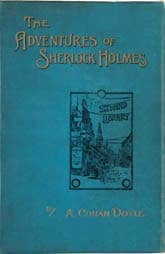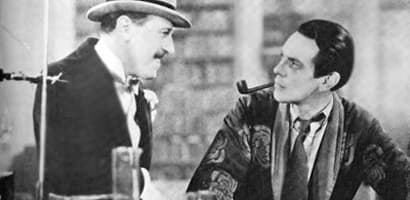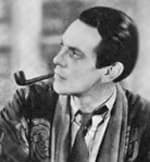The Adventures of Sherlock Holmes
Critique • Quotes • Text • Sherlock Holmes at the movies
 First edition
First editionFirst publication
1892
Literature form
Story collection
Genres
Crime, mystery
Writing language
English
Author's country
England
Length
Twelve stories, approx. 94,000 words

Raymond Massey, right, as Holmes with Roland Young as his Watson in The Speckled Band.
Unsound Holmes in the sound era
The Return of Sherlock Holmes (1929): Film, 71 minutes; director Basil Dean; writers Basil Dean, Garrett Fort; featuring Clive Brook, H. Reeves-Smith
Sherlock Holmes (1932): Film, 68 minutes; director William K. Howard; writer Bertram Millhauser; featuring Clive Brook, Reginald Owen, Ernest Torrence
The Speckled Band (1931): Film, 90 minutes; director Jack Raymond; writer W.P. Lipcomb; featuring Raymond Massey, Athole Stewart, Lyn Harding
A Study in Scarlet (1933): Film, 71 minutes; director Edwin L. Marin; writer Robert Florey; featuring Reginald Owen, Warburton Gamble, Alan Mowbray
As silent pictures were being replaced by talkies in the late 1920s and early 1930s, studios and lead actors competed to establish series based on the Holmes canon—a trend that has never let up. To date, more than seventy actors have played the detective in about two hundred and forty films, plus hundreds of television episodes.
Oddly, from our perspective today, most of those first few cinematic attempts to portray the world's most famous consulting detective with sound were not very successful.
Among the contending films in 1932 is Sherlock Holmes, actually adapted from the William Gillette stage play (like the earlier Barrymore film). It stars silent-era veteran Clive Brook. Suffice it to show how far Brook's character strayed from both the books and the play to note the movie starts with the sleuth—that famously sexless, confirmed bachelor—about to be married!
Paradoxically, this movie is actually a sequel to Brook's The Return of Sherlock Holmes in 1929. It's that earlier movie that revises the Gillette-turned "Elementary, my dear fellow" phrase into the form of "Elementary, my dear Watson", which gets picked up by later films, although neither expression ever appeared in Doyle's writing.
Otherwise, both Brook films are disasters for Holmes fans but the second one is notable for its Watson being played by the estimable Reginald Owen (A Christmas Carol).
Big improvement
Owen got little screen time as the sidekick in the 1932 Brook film, but he was encouraged to take on the main role himself the following year. Owen even helped write A Study in Scarlet (1933) in hopes of launching a popular series with himself as the detective.
Although it's a vast improvement, A Study in Scarlet unfortunately is not faithful enough to excite avid Sherlockians. It's not really based on the novel of that name. The plot and subsidiary characters are entirely different, as the producers had bought rights to only the title (although I've counted at least two lines lifted almost verbatim from the book).
Owen's Holmes, operating in contemporary times, is an affable and suave gentleman and his Watson (Warburton Gamble) is a stuffy, obsequious fellow, more like the English butler in old films.
The storyline is that of a decent mystery thriller of the era, involving a series of murders, an exotic femme fatale, secret passageways and a murky atmosphere. There's even a Moriarty-style villain, called (in near-parody) Merrydew.
But Owen's dream failed to catch on and the projected series ended with this first instalment.
Modernized Holmes
In the meantime, Canadian-born Raymond Massey offered a quite different take on Holmes in The Speckled Band (1931). It was not the first adaptation of Doyle's story of that name from The Adventures collection, as there had been a silent treatment in 1923.
This new version is hardly out of the silent era either, with melodramatic acting from much of the cast, including Lyn Harding as the villain (more on him in later Holmes filmography), and with attempts at some very early special effects, such as double exposures.
The film is big on atmospherics, trying to create a spooky feeling of foreboding, despite the story being set in (then) contemporary times. Holmes himself is shown in a bizarre modern light, operating a modern crime detection office set up by Watson (Athole Stewart) with what seem to be proto-computers to track criminals around the world. Although some scenes are quite evocative, the overall juxtaposition of the sequences of ultramodern crime detection with Victorian-era horror thrills makes for a movie of split personality, so no one tone appropriate to Sherlockian mystery is set.
Massey though is the most relaxed, even languid, actor in the film, quietly amused by the overacted antics of those around him, until he's required to leap into action to defeat the "speckled band". Given the proper vehicles, he would have made a fine Holmes in a film series.
Unfortunately he's not in this short movie enough—available copies run anywhere from forty-two to ninety minutes—with the villain, the damsel in distress and a bald Dr. Watson (Athole Stewart) taking up most of the screen time.
The entire film of The Speckled Band starring Raymond Massey.
Massey would never again play Holmes in a feature film.
(He would make many more and better movies though, including most memorably in his senior years the modern classic East of Eden.)
— Eric
Critique • Quotes • Text • Sherlock Holmes at the movies
1922, 1929–1933, 1931–1937, 1939–1946, 1954–1955, 1959–1984, 1962–1992, 1965, 1970, 1975–1988, 1976, 1979, 1982, 1984–1994, 2000–2002, 2002, 2002b, 2009–2011, 2010–2017, 2012–2019, 2015




